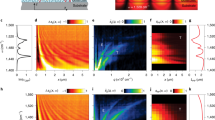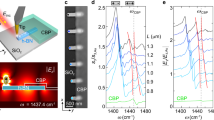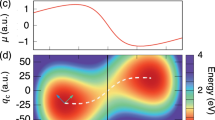Abstract
Strong coupling is a fundamental concept in physics that describes extreme interactions between light and matter. Recent experiments have demonstrated strong coupling at the nanometre scale, where strongly confined polaritons, rather than photons, couple to quantum emitters or molecular vibrations. Coupling with the latter is generally referred to as vibrational strong coupling (VSC) and is of substantial fundamental and technological interest, as it can be an effective tool for modifying molecular properties. However, the implementation of VSC, especially at the nanoscale, depends on the development of tuning mechanisms that allow control over the coupling strength and, eventually, its directionality, opening the door for the selective coupling of specific molecular vibrations. Here we report the observation of directional VSC, which we carried out at the nanoscale. Specifically, we show the nanoscale images of propagating hyperbolic phonon polaritons coupled to pentacene molecules, revealing that the fingerprint of VSC for propagating polaritons—a marked anticrossing in their dispersion at the vibrational resonance—can be modulated as a function of the direction of propagation. In addition, we show that VSC can exhibit an optimal condition for thin molecular layers, characterized by the maximum coupling strength along a single direction. This phenomenon is understood by analysing the overlap of the polariton field with molecular layers of varying thicknesses. Apart from their fundamental importance, our findings promise novel applications for directional sensing or local directional control of chemical properties at the nanoscale.
This is a preview of subscription content, access via your institution
Access options
Access Nature and 54 other Nature Portfolio journals
Get Nature+, our best-value online-access subscription
$32.99 / 30 days
cancel any time
Subscribe to this journal
Receive 12 print issues and online access
$259.00 per year
only $21.58 per issue
Buy this article
- Purchase on SpringerLink
- Instant access to full article PDF
Prices may be subject to local taxes which are calculated during checkout



Similar content being viewed by others
Data availability
All data supporting the findings of this study are available in the Article and the Supplementary Information. Additional data can be obtained from the corresponding authors upon reasonable request.
References
Park, K.-D. et al. Tip-enhanced strong coupling spectroscopy, imaging, and control of a single quantum emitter. Sci. Adv. 5, eaav5931 (2019).
Chikkaraddy, R. et al. Single-molecule strong coupling at room temperature in plasmonic nanocavities. Nature 535, 127–130 (2016).
Sternbach, A. J. et al. Negative refraction in hyperbolic hetero-bicrystals. Science 379, 555–557 (2023).
García-Vidal, F. J., Ciuti, C. & Ebbesen, T. W. Manipulating matter by strong coupling to vacuum fields. Science 373, eabd0336 (2021).
Nagarajan, K., Thomas, A. & Ebbesen, T. W. Chemistry under vibrational strong coupling. J. Am. Chem. Soc. 143, 16877–16889 (2021).
Ebbesen, T. W. Hybrid light-matter states in a molecular and material science perspective. Acc. Chem. Res. 49, 2403–2412 (2016).
Bhuyan, R. et al. The rise and current status of polaritonic photochemistry and photophysics. Chem. Rev. 123, 10877–10919 (2023).
Xiang, B. & Xiong, W. Molecular polaritons for chemistry, photonics and quantum technologies. Chem. Rev. 124, 2512–2552 (2024).
Basov, D. N., Fogler, M. M. & de Abajo, F. J. G. Polaritons in van der Waals materials. Science 354, aag1992 (2016).
Low, T. et al. Polaritons in layered two-dimensional materials. Nat. Mater. 16, 182–194 (2017).
Zhang, Q. et al. Interface nano-optics with van der Waals polaritons. Nature 597, 187–195 (2021).
Bylinkin, A. et al. Real-space observation of vibrational strong coupling between propagating phonon polaritons and organic molecules. Nat. Photon. 15, 197–202 (2021).
Autore, M. et al. Boron nitride nanoresonators for phonon-enhanced molecular vibrational spectroscopy at the strong coupling limit. Light Sci. Appl. 7, 17172 (2018).
Dolado, I. et al. Remote near-field spectroscopy of vibrational strong coupling between organic molecules and phononic nanoresonators. Nat. Commun. 13, 6850 (2022).
Barra-Burillo, M. et al. Microcavity phonon polaritons from the weak to the ultrastrong phonon-photon coupling regime. Nat. Commun. 12, 6206 (2021).
Ma, W. et al. In-plane anisotropic and ultra-low-loss polaritons in a natural van der Waals crystal. Nature 562, 557–562 (2018).
Álvarez-Pérez, G. et al. Infrared permittivity of the biaxial van der Waals semiconductor α-MoO3 from near- and far-field correlative studies. Adv. Mater. 32, 1908176 (2020).
Duan, J. et al. Planar refraction and lensing of highly confined polaritons in anisotropic media. Nat. Commun. 12, 4325 (2021).
Álvarez-Pérez, G. et al. Negative reflection of nanoscale-confined polaritons in a low-loss natural medium. Sci. Adv. 8, eabp8486 (2022).
Ruiz, R. et al. Pentacene thin film growth. Chem. Mater. 16, 4497–4508 (2004).
Shioya, N. et al. Alternative face-on thin film structure of pentacene. Sci. Rep. 9, 579 (2019).
Dai, S. et al. Efficiency of launching highly confined polaritons by infrared light incident on a hyperbolic material. Nano Lett. 17, 5285–5290 (2017).
Fei, Z. et al. Gate-tuning of graphene plasmons revealed by infrared nano-imaging. Nature 487, 82–85 (2012).
Chen, J. et al. Optical nano-imaging of gate-tunable graphene plasmons. Nature 487, 77–81 (2012).
Novotny, L. Strong coupling, energy splitting, and level crossings: a classical perspective. Am. J. Phys. 78, 1199–1202 (2010).
Passler, N. C. & Paarmann, A. Generalized 4 × 4 matrix formalism for light propagation in anisotropic stratified media: study of surface phonon polaritons in polar dielectric heterostructures. J. Opt. Soc. Am. B 34, 2128 (2017).
Álvarez-Pérez, G., Voronin, K. V., Volkov, V. S., Alonso-González, P. & Nikitin, A. Y. Analytical approximations for the dispersion of electromagnetic modes in slabs of biaxial crystals. Phys. Rev. B 100, 235408 (2019).
Törmä, P. & Barnes, W. L. Strong coupling between surface plasmon polaritons and emitters: a review. Rep. Prog. Phys. 78, 013901 (2015).
Voronin, K. V., Álvarez-Pérez, G., Lanza, C., Alonso-González, P. & Nikitin, A. Y. Fundamentals of polaritons in strongly anisotropic thin crystal layers. ACS Photonics 11, 550–560 (2024).
Thomas, A. et al. Tilting a ground-state reactivity landscape by vibrational strong coupling. Science 363, 615–619 (2019).
Lather, J., Bhatt, P., Thomas, A., Ebbesen, T. W. & George, J. Cavity catalysis by cooperative vibrational strong coupling of reactant and solvent molecules. Angew. Chem. Int. Ed. 58, 8698–8702 (2019).
Campos-Gonzalez-Angulo, J. A., Ribeiro, R. F. & Yuen-Zhou, J. Resonant catalysis of thermally activated chemical reactions with vibrational polaritons. Nat. Commun. 10, 4685 (2019).
Acknowledgements
We acknowledge support from the Spanish Ministry of Science and Innovation (grants PID2022-141304NB-I00 and PID2023-147676NB-I00). A.I.F.T.-M. and J.Á.-C. acknowledge support through the Severo Ochoa programme from the Government of the Principality of Asturias (numbers PA-21-PF-BP20-117 and PA-22-PF-BP21-100). K.V.V. acknowledges support from a fellowship from ‘la Caixa’ Foundation (ID 100010434); the fellowship code is LCF/BQ/DI21/11860026. J.T.-G. acknowledges support from the Swiss National Foundation (grant number 200020_201096). A.M. and P.D.-N. acknowledge support from the European Research Council (ERC) under the European Union’s Horizon 2020 research and innovation programme (Consolidator grant agreement number 865590, Programmable Matter). J.M.-S. acknowledges financial support from the Spanish Ministry of Science and Innovation (grant number PID2023-148457NB-I00, funded by MCIN/AEI/10.13039/501100011033 and FSE+), PCI2022-132953 (funded by MCIN/AEI/10.13039/501100011033 and the EU ‘NextGenerationEU’/PRTR) and CNS2024-154342 (funded by MICIU/AEI/10.13039/501100011033). P.A.-G. acknowledges financial support from the ERC under Consolidator grant number 101044461, TWISTOPTICS. A.Y.N. acknowledges the Basque Department of Education (grant number PIBA-2023-1-0007) and the IKUR strategy.
Author information
Authors and Affiliations
Contributions
P.A.-G. and A.Y.N. conceived the study. A.I.F.T.-M. performed the sample fabrication and near-field experiments with the help of J.T.-G., A.T.M.-L. and J.D. O.G.M., C.L. and J.Á.-C. performed the analytical study and simulations with input from K.V.V. and G.A.-P., under the supervision of V.S.V. and A.Y.N. P.D.-N. and A.M. performed the nano-Fourier transform infrared (nano-FTIR) spectroscopy measurements. F.C. and G.A. performed the fabrication of the pentacene films under the supervision of L.E.H. A.B., J.M.-S. and R.H. participated in the data analysis. A.I.F.T.-M., C.L. and P.A.-G. wrote the manuscript with input from the rest of the authors. P.A.-G. and A.Y.N. supervised the work. All authors contributed to the scientific discussion and manuscript revisions.
Corresponding authors
Ethics declarations
Competing interests
R.H. is a co-founder of Neaspec GmbH, a company that manufactures s-SNOM systems, including the one used in this study. The other authors declare no competing interests.
Peer review
Peer review information
Nature Photonics thanks the anonymous reviewers for their contribution to the peer review of this work.
Additional information
Publisher’s note Springer Nature remains neutral with regard to jurisdictional claims in published maps and institutional affiliations.
Supplementary information
Supplementary Information
Supplementary Figs. 1–20, Table 1 and Notes I–VII.
Rights and permissions
Springer Nature or its licensor (e.g. a society or other partner) holds exclusive rights to this article under a publishing agreement with the author(s) or other rightsholder(s); author self-archiving of the accepted manuscript version of this article is solely governed by the terms of such publishing agreement and applicable law.
About this article
Cite this article
F. Tresguerres-Mata, A.I., Matveeva, O.G., Lanza, C. et al. Directional strong coupling at the nanoscale between hyperbolic polaritons and organic molecules. Nat. Photon. (2025). https://doi.org/10.1038/s41566-025-01762-6
Received:
Accepted:
Published:
DOI: https://doi.org/10.1038/s41566-025-01762-6



